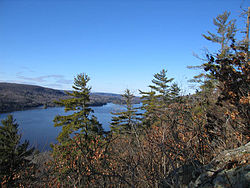|
Gatineau River
The Gatineau River (French: Rivière Gatineau, pronounced [gatino]) is a river in western Quebec, Canada, which rises in lakes north of the Baskatong Reservoir and flows south to join the Ottawa River at the city of Gatineau, Quebec. The river is 386 kilometres (240 mi) long and drains an area of 23,700 square kilometres (9,200 sq mi). GeographyThe geography of the area was altered with the construction of the Baskatong Reservoir, and it is still possible to travel upstream on the Gatineau and reach a point where a small portage leads to the headwaters of the Ottawa River. The Ottawa River then flows northwest and turns south where it eventually flows more easterly and connects with the Gatineau. The river flows through the communities of: A covered wooden bridge over the river at Wakefield, built in 1915, was destroyed by arson in 1984, but has been rebuilt. HistoryExploration and naming  This river was an important transportation corridor for native people of the region and early explorers. On June 4, 1613, Samuel de Champlain passed here while travelling on the Ottawa River to L'Isle-aux-Allumettes. He noted this "river coming from the north" but did not give its name. ToponomyAccording to the Bulletin des recherches historiques (1895), the land-surveyor Noël Beaupré wrote an official report on the river on February 3, 1721, but without naming it, leaving it unclear if its current name was in use in the 18th century. There are two hypotheses to explain the origin of the city's name. It would be either of Indigenous origin or of French origin:
The toponym Lettinoe, Gateno, Gatteno and Gatineau appears:
Economic uses From the 19th century until 1991, the river was used to transport logs to sawmills near the mouth of the river. Philemon Wright and his descendants played an important role in the development of the lumber industry in the Gatineau valley. In more recent times, with declining quality in the forests of the region, logs were used for pulp and paper. The river has been extensively dammed and is an important source of hydroelectric power. In 1925, three hydroelectric dams were constructed along the lower Gatineau River, making them one of the biggest economic and industrial projects in the region's history. These are now known today as the Paugan, Chelsea and Rapides-Farmers Hydroelectric Stations (Centrale Paugan, Centrale Chelsea and Centrale Rapides-Farmers). The stations are located within the municipalities of Low, Cantley and Gatineau.[6] The Hull–Chelsea–Wakefield Railway, a tourist steam train, followed a route up the Gatineau valley to Wakefield.  In 1915, Canadian artist and member of the Group of Seven J. E. H. MacDonald would depict logging operations on the river is his painting, Logs on the Gatineau.[7] FloodingIn the spring of 1974, there was extensive flooding along the Gatineau.  TributariesMajor tributaries of the Gatineau River in upstream order are:[8]
See alsoReferences
External linksWikimedia Commons has media related to Gatineau River.
|
||||||||||||||||||||||||||||||||||||||||||||

